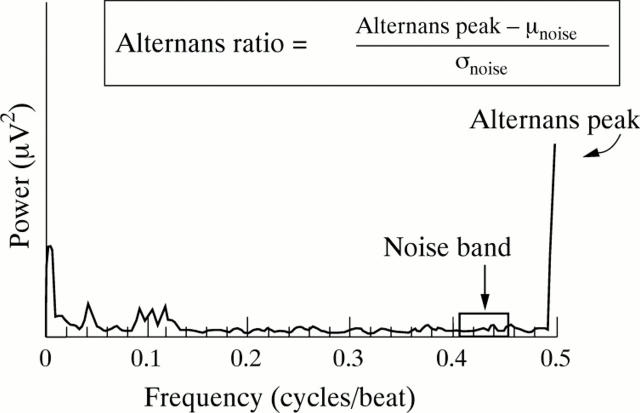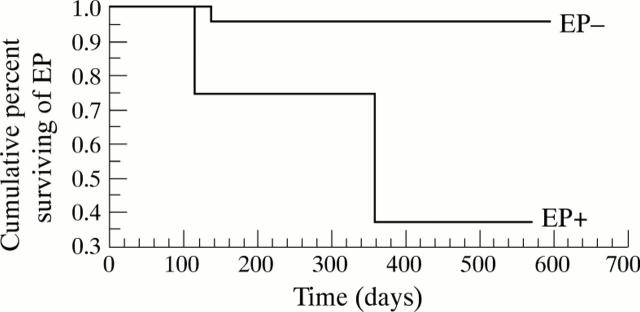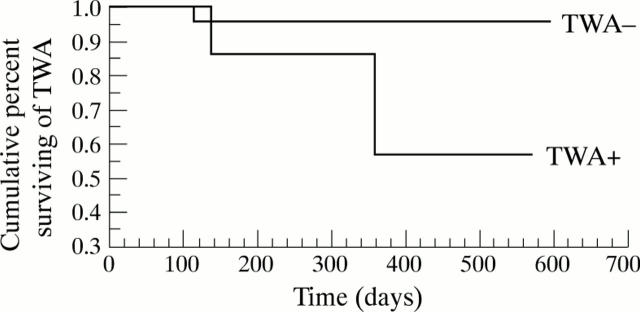Abstract
Objective—To investigate the accuracy of signal averaged electrocardiography (SAECG) and measurement of microvolt level T wave alternans as predictors of susceptibility to ventricular arrhythmias. Design—Analysis of new data from a previously published prospective investigation. Setting—Electrophysiology laboratory of a major referral hospital. Patients and interventions—43 patients, not on class I or class III antiarrhythmic drug treatment, undergoing invasive electrophysiological testing had SAECG and T wave alternans measurements. The SAECG was considered positive in the presence of one (SAECG-I) or two (SAECG-II) of three standard criteria. T wave alternans was considered positive if the alternans ratio exceeded 3.0. Main outcome measures—Inducibility of sustained ventricular tachycardia or fibrillation during electrophysiological testing, and 20 month arrhythmia-free survival. Results—The accuracy of T wave alternans in predicting the outcome of electrophysiological testing was 84% (p < 0.0001). Neither SAECG-I (accuracy 60%; p < 0.29) nor SAECG-II (accuracy 71%; p < 0.10) was a statistically significant predictor of electrophysiological testing. SAECG, T wave alternans, electrophysiological testing, and follow up data were available in 36 patients while not on class I or III antiarrhythmic agents. The accuracy of T wave alternans in predicting the outcome of arrhythmia-free survival was 86% (p < 0.030). Neither SAECG-I (accuracy 65%; p < 0.21) nor SAECG-II (accuracy 71%; p < 0.48) was a statistically significant predictor of arrhythmia-free survival. Conclusions—T wave alternans was a highly significant predictor of the outcome of electrophysiological testing and arrhythmia-free survival, while SAECG was not a statistically significant predictor. Although these results need to be confirmed in prospective clinical studies, they suggest that T wave alternans may serve as a non-invasive probe for screening high risk populations for malignant ventricular arrhythmias. Keywords: electrophysiological testing; electrical alternans; signal averaged electrocardiography; arrhythmias
Full Text
The Full Text of this article is available as a PDF (117.4 KB).
Figure 1 .
Representative example of power spectrum of beat to beat fluctuations in T wave morphology. The alternans ratio is the amplitude of the spectrum at the alternans frequency (alternans peak) minus the mean background noise level (noise), divided by the standard deviation of the noise (noise) in the reference noise band.
Figure 2 .
Arrhythmia-free survival of patients with positive/negative electrophysiological testing (EP).
Figure 3 .
Arrhythmia-free survival of patients with positive/negative T wave alternans (TWA).
Figure 4 .
Arrhythmia-free survival of patients with positive/negative signal averaged electrocardiography (SAECG, one or two criteria).
Selected References
These references are in PubMed. This may not be the complete list of references from this article.
- Armoundas A. A., Cohen R. J. Clinical utility of T-wave alternans. Card Electrophysiol Rev. 1997;1(3):390–394. doi: 10.1023/a:1009902030340. [DOI] [PubMed] [Google Scholar]
- Breithardt G., Cain M. E., el-Sherif N., Flowers N., Hombach V., Janse M., Simson M. B., Steinbeck G. Standards for analysis of ventricular late potentials using high resolution or signal-averaged electrocardiography. A statement by a Task Force Committee between the European Society of Cardiology, the American Heart Association and the American College of Cardiology. Eur Heart J. 1991 Apr;12(4):473–480. doi: 10.1093/oxfordjournals.eurheartj.a059926. [DOI] [PubMed] [Google Scholar]
- Clancy E. A., Smith J. M., Cohen R. J. A simple electrical-mechanical model of the heart applied to the study of electrical-mechanical alternans. IEEE Trans Biomed Eng. 1991 Jun;38(6):551–560. doi: 10.1109/10.81580. [DOI] [PubMed] [Google Scholar]
- Estes N. A., 3rd, Michaud G., Zipes D. P., El-Sherif N., Venditti F. J., Rosenbaum D. S., Albrecht P., Wang P. J., Cohen R. J. Electrical alternans during rest and exercise as predictors of vulnerability to ventricular arrhythmias. Am J Cardiol. 1997 Nov 15;80(10):1314–1318. doi: 10.1016/s0002-9149(97)00694-2. [DOI] [PubMed] [Google Scholar]
- Goedel-Meinen L., Hofmann M., Schmidt G., Maier-Rudolph W., Barthel P., Schrag A., Baedeker W., Blömer H. Amiodarone--efficacy and late potentials during long-term therapy. Int J Clin Pharmacol Ther Toxicol. 1990 Nov;28(11):449–454. [PubMed] [Google Scholar]
- Gomes J. A., Winters S. L., Martinson M., Machac J., Stewart D., Targonski A. The prognostic significance of quantitative signal-averaged variables relative to clinical variables, site of myocardial infarction, ejection fraction and ventricular premature beats: a prospective study. J Am Coll Cardiol. 1989 Feb;13(2):377–384. doi: 10.1016/0735-1097(89)90515-9. [DOI] [PubMed] [Google Scholar]
- Gomes J. A., Winters S. L., Stewart D., Horowitz S., Milner M., Barreca P. A new noninvasive index to predict sustained ventricular tachycardia and sudden death in the first year after myocardial infarction: based on signal-averaged electrocardiogram, radionuclide ejection fraction and Holter monitoring. J Am Coll Cardiol. 1987 Aug;10(2):349–357. doi: 10.1016/s0735-1097(87)80018-9. [DOI] [PubMed] [Google Scholar]
- Kuchar D. L., Thorburn C. W., Sammel N. L. Prediction of serious arrhythmic events after myocardial infarction: signal-averaged electrocardiogram, Holter monitoring and radionuclide ventriculography. J Am Coll Cardiol. 1987 Mar;9(3):531–538. doi: 10.1016/s0735-1097(87)80045-1. [DOI] [PubMed] [Google Scholar]
- Mercando A. D., Aronow W. S., Epstein S., Fishbach M. Signal-averaged electrocardiography and ventricular tachycardia as predictors of mortality after acute myocardial infarction in elderly patients. Am J Cardiol. 1995 Sep 1;76(7):436–440. doi: 10.1016/s0002-9149(99)80126-x. [DOI] [PubMed] [Google Scholar]
- Platt S. B., Vijgen J. M., Albrecht P., Van Hare G. F., Carlson M. D., Rosenbaum D. S. Occult T wave alternans in long QT syndrome. J Cardiovasc Electrophysiol. 1996 Feb;7(2):144–148. doi: 10.1111/j.1540-8167.1996.tb00509.x. [DOI] [PubMed] [Google Scholar]
- Rosenbaum D. S., Jackson L. E., Smith J. M., Garan H., Ruskin J. N., Cohen R. J. Electrical alternans and vulnerability to ventricular arrhythmias. N Engl J Med. 1994 Jan 27;330(4):235–241. doi: 10.1056/NEJM199401273300402. [DOI] [PubMed] [Google Scholar]
- Savard P., Rouleau J. L., Ferguson J., Poitras N., Morel P., Davies R. F., Stewart D. J., Talajic M., Gardner M., Dupuis R. Risk stratification after myocardial infarction using signal-averaged electrocardiographic criteria adjusted for sex, age, and myocardial infarction location. Circulation. 1997 Jul 1;96(1):202–213. doi: 10.1161/01.cir.96.1.202. [DOI] [PubMed] [Google Scholar]
- Smith J. M., Clancy E. A., Valeri C. R., Ruskin J. N., Cohen R. J. Electrical alternans and cardiac electrical instability. Circulation. 1988 Jan;77(1):110–121. doi: 10.1161/01.cir.77.1.110. [DOI] [PubMed] [Google Scholar]
- Smith J. M., Cohen R. J. Simple finite-element model accounts for wide range of cardiac dysrhythmias. Proc Natl Acad Sci U S A. 1984 Jan;81(1):233–237. doi: 10.1073/pnas.81.1.233. [DOI] [PMC free article] [PubMed] [Google Scholar]
- Turitto G., Caref E. B., Macina G., Fontaine J. M., Ursell S. N., el-Sherif N. Time course of ventricular arrhythmias and the signal averaged electrocardiogram in the post-infarction period: a prospective study of correlation. Br Heart J. 1988 Jul;60(1):17–22. doi: 10.1136/hrt.60.1.17. [DOI] [PMC free article] [PubMed] [Google Scholar]
- Turitto G., Fontaine J. M., Ursell S. N., Caref E. B., Henkin R., el-Sherif N. Value of the signal-averaged electrocardiogram as a predictor of the results of programmed stimulation in nonsustained ventricular tachycardia. Am J Cardiol. 1988 Jun 1;61(15):1272–1278. doi: 10.1016/0002-9149(88)91168-x. [DOI] [PubMed] [Google Scholar]
- el-Sherif N., Ursell S. N., Bekheit S., Fontaine J., Turitto G., Henkin R., Caref E. B. Prognostic significance of the signal-averaged ECG depends on the time of recording in the postinfarction period. Am Heart J. 1989 Aug;118(2):256–264. doi: 10.1016/0002-8703(89)90183-x. [DOI] [PubMed] [Google Scholar]






